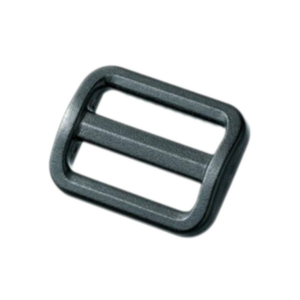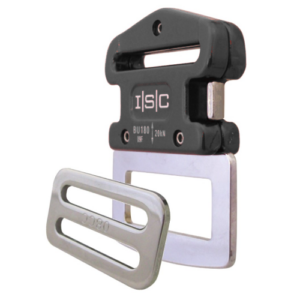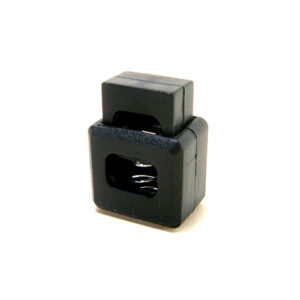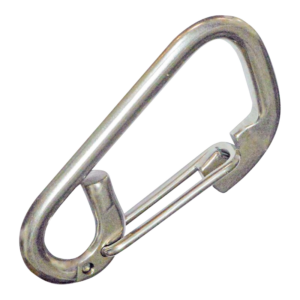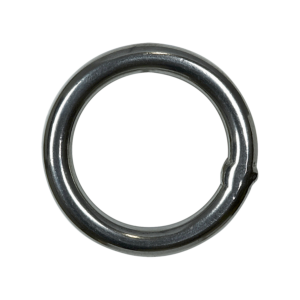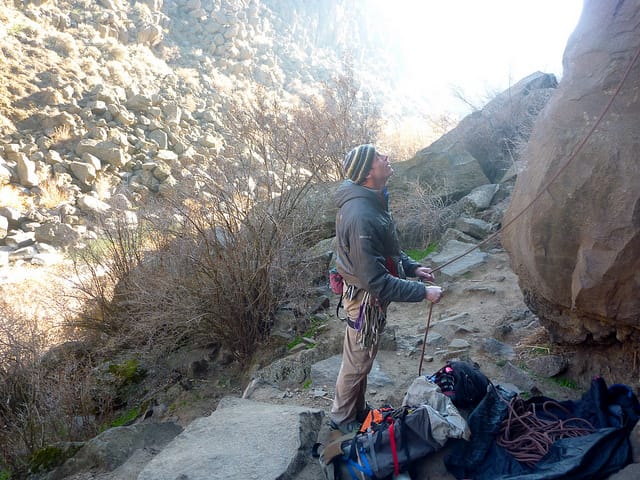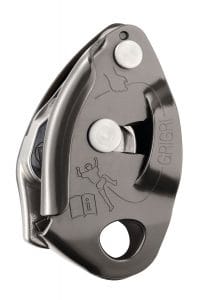Consider the kind of equipment you use when you’re rock climbing. You have your rope, your harness, your shoes — and of course, your belay device. The integrity of all this equipment is important, as essentially your life depends on it. Picking out the right climbing equipment can be difficult because of the number of options. There is probably the most variety in belay devices. With so many different products on the market, it can be hard to determine which one is right for you. Let’s take a look at the different kinds of belay devices, go over their components, primary uses, and the types of climbing suited for each.
The Munter Hitch
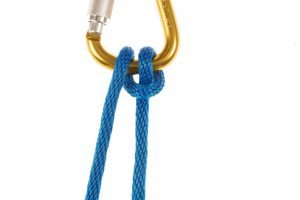 While this is technically a knot rather than a physical device, the Munter is important to mention for a few reasons. First, all you need is a locking carabiner. If you happen to drop your belay device on a multi-pitch climb and need to retreat or continue, you can tie a munter hitch and belay or rappel using just a carabiner. While not recommended if you have a belay device in you possession, it can be used in case of an emergency. Take a look at these locking carabiners.
While this is technically a knot rather than a physical device, the Munter is important to mention for a few reasons. First, all you need is a locking carabiner. If you happen to drop your belay device on a multi-pitch climb and need to retreat or continue, you can tie a munter hitch and belay or rappel using just a carabiner. While not recommended if you have a belay device in you possession, it can be used in case of an emergency. Take a look at these locking carabiners.
Figure Eight Belay Device
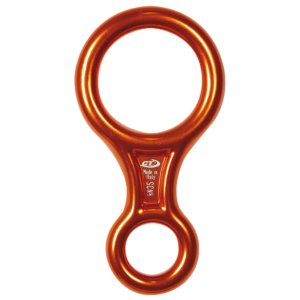 This is still a popular device in Europe, although it’s most commonly used for rappelling. These are the simplest kind of belay devices, often utilised in search and rescue and caving. The device has two holes: one large and one small. A bight of rope is fed through the larger hole and looped around the outside of the small hole, which is clipped into the belay loop on your harness. The rope is locked off to the belayer’s side, and in this way it makes for a sufficient situation in which to halt the rope’s movement. It’s popularly used for rappelling because its extra bulk dissipates heat quickly and allows for a smooth descent. The main drawback is the decreased friction allocated by the device, which can necessitate added strength and attention when catching a large fall. It also puts a twist in the rope, which can make rope handling more difficult. With all of the other belay devices to choose from, this one is not recommended for beginners. Here are a few figure eight belay devices.
This is still a popular device in Europe, although it’s most commonly used for rappelling. These are the simplest kind of belay devices, often utilised in search and rescue and caving. The device has two holes: one large and one small. A bight of rope is fed through the larger hole and looped around the outside of the small hole, which is clipped into the belay loop on your harness. The rope is locked off to the belayer’s side, and in this way it makes for a sufficient situation in which to halt the rope’s movement. It’s popularly used for rappelling because its extra bulk dissipates heat quickly and allows for a smooth descent. The main drawback is the decreased friction allocated by the device, which can necessitate added strength and attention when catching a large fall. It also puts a twist in the rope, which can make rope handling more difficult. With all of the other belay devices to choose from, this one is not recommended for beginners. Here are a few figure eight belay devices.
Tubular Belay Devices
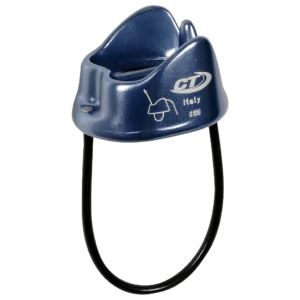 These are the most common types of belay devices — which many of us have come to know and love. They are suitable for any kind of climbing: sport, traditional, gym climbing, single pitch, multi-pitch, or rappelling. Tuber devices have two slots. When used for belaying, you insert a bent rope bight through one slot and then clip a carabiner through the loop, attaching the carabiner to the belay loop on your harness. Friction is created by the shape of the bent rope against the belay device, which assists in stopping the rope. Advanced tuber devices have teeth or grooves for extra friction. When used for rappelling, you can insert both rope strands through the dual slots. The advantages to these devices include compactness, the ability to use varying diameters of ropes, and double or single ropes. The ropes don’t get twisted up and tubular belay devices are easy to use for rappelling. They are recognised as the industry standard in many countries. The Doble V-Row belay device is a great tubular option.
These are the most common types of belay devices — which many of us have come to know and love. They are suitable for any kind of climbing: sport, traditional, gym climbing, single pitch, multi-pitch, or rappelling. Tuber devices have two slots. When used for belaying, you insert a bent rope bight through one slot and then clip a carabiner through the loop, attaching the carabiner to the belay loop on your harness. Friction is created by the shape of the bent rope against the belay device, which assists in stopping the rope. Advanced tuber devices have teeth or grooves for extra friction. When used for rappelling, you can insert both rope strands through the dual slots. The advantages to these devices include compactness, the ability to use varying diameters of ropes, and double or single ropes. The ropes don’t get twisted up and tubular belay devices are easy to use for rappelling. They are recognised as the industry standard in many countries. The Doble V-Row belay device is a great tubular option.
Guide Plates
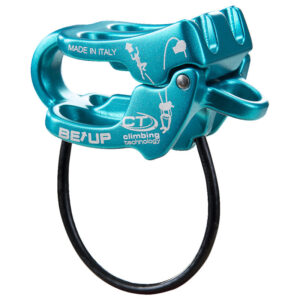 Guide plates are essentially an advanced type of tubular device. These tubers have a large attachment point at one end and a smaller point at the other. The biggest advantage to a guide plate? When on a multi-pitch climb, you can use a guide plate to belay up your second. The large metal loop allows you to attach the device to your anchor point. While it works the same as a standard tuber device when belaying the lead climber, being able to use it to bring up your second makes for enhanced versatility. Its assisted braking feature also allows for easy lowering of a climber. The guide plate is an extremely popular belay device for use in multi-pitch climbing, and the CT Be Up is a reliable option.
Guide plates are essentially an advanced type of tubular device. These tubers have a large attachment point at one end and a smaller point at the other. The biggest advantage to a guide plate? When on a multi-pitch climb, you can use a guide plate to belay up your second. The large metal loop allows you to attach the device to your anchor point. While it works the same as a standard tuber device when belaying the lead climber, being able to use it to bring up your second makes for enhanced versatility. Its assisted braking feature also allows for easy lowering of a climber. The guide plate is an extremely popular belay device for use in multi-pitch climbing, and the CT Be Up is a reliable option.
Passive Assisted Braking Belay Devices
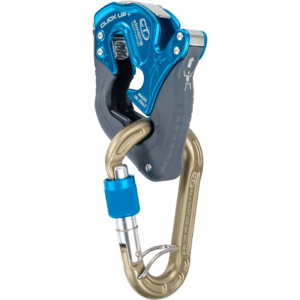 The word passive in this scenario can be defined as “having no moving parts”. These types of devices are highlighted by a mechanism that pinches the rope between the carabiner and the device, assisting in halting the movement of the rope, although it’s important to mention here that no belay device is “hands-free”. The advantages of passive assisted braking devices over their active counterparts are that they are lightweight, suitable for any kind of climbing, and can often be used to rappel on two strands of rope. The CT Click Up Plus (Single Rope) and CT Alpine Up (Dual Rope) are trusted semi-auto blocking device, ideal for all types of climbing.
The word passive in this scenario can be defined as “having no moving parts”. These types of devices are highlighted by a mechanism that pinches the rope between the carabiner and the device, assisting in halting the movement of the rope, although it’s important to mention here that no belay device is “hands-free”. The advantages of passive assisted braking devices over their active counterparts are that they are lightweight, suitable for any kind of climbing, and can often be used to rappel on two strands of rope. The CT Click Up Plus (Single Rope) and CT Alpine Up (Dual Rope) are trusted semi-auto blocking device, ideal for all types of climbing.
Active Assisted Braking Belay Devices
These are the most technologically advanced belay devices currently on the market. Active assisted braking devices function by pinching the rope between a camming mechanism within the device itself. They generally serve to work with a single strand of rope, which means they cannot be used for rappelling. These devices are ideal for belaying climbers on single pitch sport routes because they tend to take some of the weight off the belayer by gripping the rope firmly when a climber hangs on the rope or falls. On a multi-pitch climb, these devices can be used to bring up a second climber. The disadvantages to active assisted braking belay devices? They are usually much heavier than their counterparts due to the weight of the camming mechanism, and cannot be used for rappelling. The Petzl GriGri2 is one of the most versatile belay and rappel devices on the market, ideal for trad and sport climbing.
How to Choose the Best Device for You
Choosing the appropriate belay device for you depends on your experience, climbing preference, and objectives. Many climbers have multiple belay devices to use in different situations or for different types of climbing. Evaluate the kind of climbing you primarily do. Do you like to project on hard sport routes? An active assisted belay device might be ideal. Do you primarily climb long, multi-pitch routes? You’ll want a device you can use to bring up your second. Some people prefer to only use a standard tuber device in all situations simply because that’s what they’re used to. It really comes down to personal preference — but now that you’re familiar with everything that’s out there, you should be able to make the appropriate choice for you.
Here is a complete list of our available belay devices.
Featured image credit: Laurel F, Flickr













